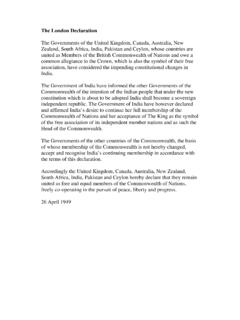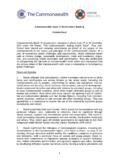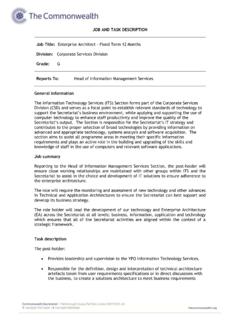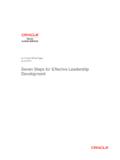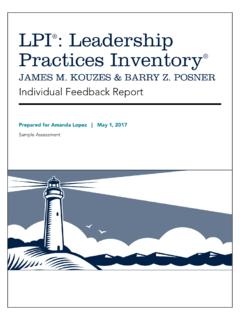Transcription of Strategies for Increased Participation of Women in ...
1 Strategies for Increased Participation of Women in leadership across the CommonwealthSeptember 2015 DISCUSSION PAPERS trategies for Increased Participation of Women in leadership across the Commonwealthii \ Strategies for Increased Participation of Women in leadership across the CommonwealthAuthor: Bronagh Hinds Commonwealth Secretariat 2015 All rights reserved. This publication may be reproduced, stored in a retrieval system, or transmitted in any form or by any means, electronic or mechanical, including photocopying, recording or otherwise provided it is used only for educational purposes and is not for resale, and provided full acknowledgement is given to the Commonwealth Secretariat as the original and opinions expressed in this publication are the responsibility of the author and should in no way be attributed to the institutions to which he is affiliated or to the Commonwealth possible, the Commonwealth Secretariat uses paper sourced from responsible forests or from sources that minimise a destructive impact on the and published by the Commonwealth Secretariat.
2 \ iii We recognize that gender equality and Women s empowerment are important for sustaina-ble development and our common future. We reaffirm our commitments to ensure Women s equal rights, access and opportunities for Participation and leadership in the economy, society and political decision-making. UN General Assembly 2012, paragraph 31 We recognise that gender equality and Women s empowerment are essential components of human development and basic human rights. The advancement of Women s rights and the education of girls are critical preconditions for effective and sustainable development. Section XII, Charter of the Commonwealth, 2013iv \ Strategies for Increased Participation of Women in leadership across the CommonwealthContents \ vContentsIntroduction 11.
3 Overview of Women s leadership globally and in the Commonwealth Private sector Public sector 72. Successful Strategies , Impact and Reasons for Effectiveness Legislating for change Norway Comprehensive strategy Canada Male Champions of Change Australia 123. Analysis of Baseline Data and Identification of Strategies for Universal Application across the Commonwealth leadership from the top Speeding up change Changing culture Organisational change Changing behaviour and practice Supporting Women 174. Stakeholder Roles Government s enabling environment Government ministries and commissions Corporate governance machineries Private sector Civil society 205. Recommendations to Bring about Change Regulating targets for diversity leadership -led comprehensive integrated strategy Change multipliers and public policy environment Commonwealth acting together 25 Endnotes 26vi \ Strategies for Increased Participation of Women in leadership across the CommonwealthIntroduction \ 1 Introduction \ 1 IntroductionThe United Nations focus on the post-2015 development goals strongly aligns Women s empowerment and gender equality with Women s leadership in economic Commonwealth Heads of Government have affirmed the importance of Women s
4 leadership , including in enterprise, and have urged the acceleration of gender mainstreaming efforts to promote the holistic empowerment of Women as a driver of gender equality, economic growth and inclusive sustainable The case for decisively tackling the obstacles that prevent Women from accessing leadership positions equally with men and for nurturing the pipeline of Women leaders has been made in global research. The presence of Women leaders has a positive impact on governance, reputation, financial success and encouraging other Women to become leaders. Governments and the private sector in a growing number of countries are introducing decisive measures to drive up Women s share of leadership positions, including through legislation, regulation, governance arrangements, new policies and approaches, consciousness-raising on bias and empowerment programmes.
5 Positive action measures are slowly making a difference in some countries in relation to Women s share of political leadership and positions on private and public boards. However, there is little change evident in Women s executive leadership or in investment to sustain the Women s talent pipeline. The priority now is to focus on agreeing and implementing Strategies and actions that speed up the pace of change and make a substantive difference. Change is more likely to be successful when it is led from the top; focuses on institutional, structural and cultural change; and is accompanied by a results framework with robust accountability. Timely reporting on the basis of comprehensive sex-disaggregated data is essential; and this needs to be comparative across the Commonwealth for benchmarking, lesson sharing and mutual organisations, national Women s machineries and equality and human rights commissions need to extend the debate on Women s leadership into the public and private sectors more consistently (in addition to the political sphere) as well as explicitly integrate Women s public and private sector leadership into the concept of and Strategies for Women s empowerment and agency.
6 Various global data sources map the progress of Women in politics and in the private and public sectors. Each source uses its own definitions and carries limitations, often making it difficult to make comparisons across countries. In 2015, the Commonwealth undertook a study of Women in government and in leadership in member countries across the private and public sectors, including in state-owned enterprises. While data from each of the sources are generally not collected on a similar basis and direct comparisons are not always valid, patterns within each and consistent trends are highlighted in this \ Strategies for Increased Participation of Women in leadership across the Commonwealth1. Overview of Women s leadership Globally and in the CommonwealthThe progress of Women into political roles has been positive but slow, and based on current trends the UN Millennium Development Goal of gender equality in political representation is likely to take another half century to Similarly, Women s progression into senior executive positions in the public and private sectors remains sluggish.
7 An increasing number of countries both within the Commonwealth and elsewhere have introduced, or are in the process of introducing, legislation to boost Women s Participation in strategic roles. Emerging data from across the globe are beginning to show the impact of legislation and regulation. International organisations such as the United Nations and the Organisation for Economic Co-operation and Development (OECD) have gender equality monitoring mechanisms in place and report on these regularly, although not all refer to Women s leadership . These data are supplemented by data published by individual nations and organisations. The World Bank, the OECD, the World Economic Forum s Global Gender Gap4 and large consultancy firms have all collated information and data on public and/or private sector leadership positions.
8 The Commonwealth also recently commissioned the collation of comparable data on Women in leadership roles across political, private and public sectors for the first time. As with all data collated across nations, there are challenges to the validity of comparisons in terms of definitions and availability of data. Nonetheless, and accepting the caveats, the data do provide a broad picture of the position of Women who operate at the top of the business world and within the public Private sectorDoubting the business case for gender diversity You don t need more proof, you need a small leap of have demonstrated that boards on which Women are represented are more likely to be financially successful, have less likelihood of governance scandals and are less likely to operate in tax Moreover, when Women are in leadership positions for example, as a chief executive officer (CEO) then it is more likely that there will be a subsequent increase in Women directors.
9 This suggests that the pipeline for the future supply of Women leaders might be enhanced once Women are in senior McKinsey review of 100 companies against the Organizational Health Index (OHI) found that companies with three or more Women in top positions (on the executive committee or board) scored higher than their Dow Jones concluded that the overall median proportion of female executives was at successful companies and at unsuccessful companies, demonstrating the value that having more females can potentially bring to a management start-ups with five or more females, 61% were successful and only 39% failed .8 Nonetheless, achieving gender-balanced leadership within the private sector remains a challenge for all countries.
10 Globally, there are fewer Women CEOs, fewer Women members of boards and only a small proportion of organisations with three or more Women on the board. While progress has been made in recent years, it remains slow. For example, few countries can demonstrate that, on aggregate, positions on public or private boards have reached the 30 per cent mark. The range of studies and analysis lead to the conclusion that fairness will not prevail for Women in the short term without legislation for targets and/or quotas. More than 20 countries have adopted this path;9 a measure that began in the political realm is gradually extending into the private hold over 12 per cent of board seats at the world s best-known companies, a rise of only per cent since 2009.




